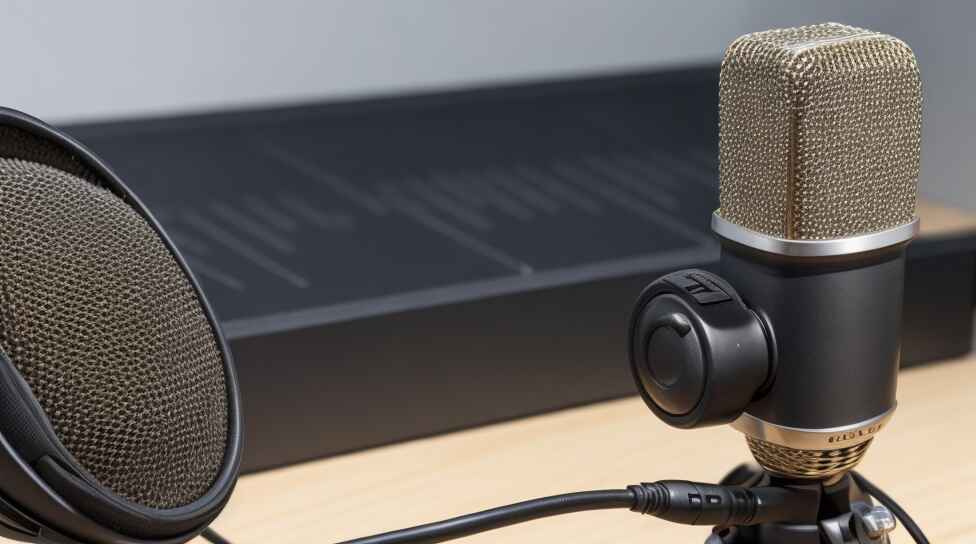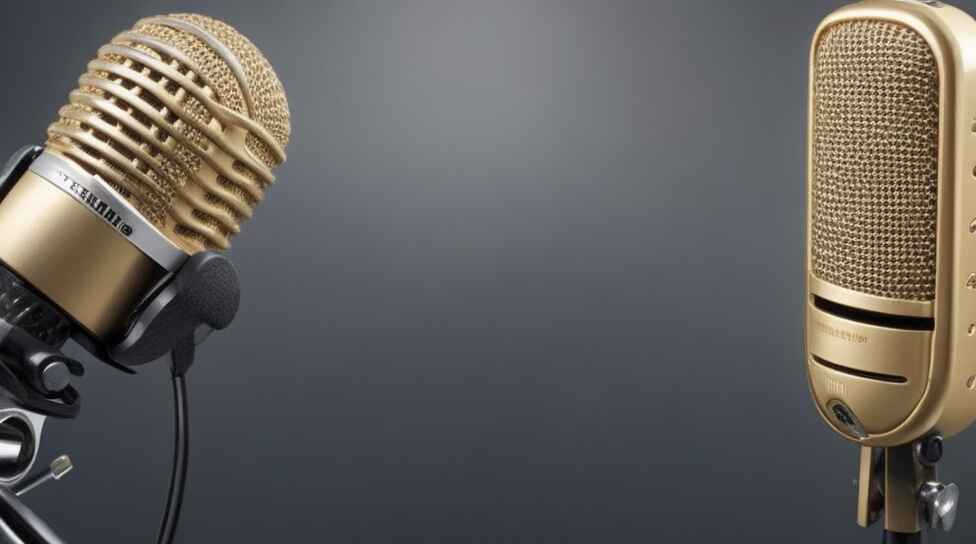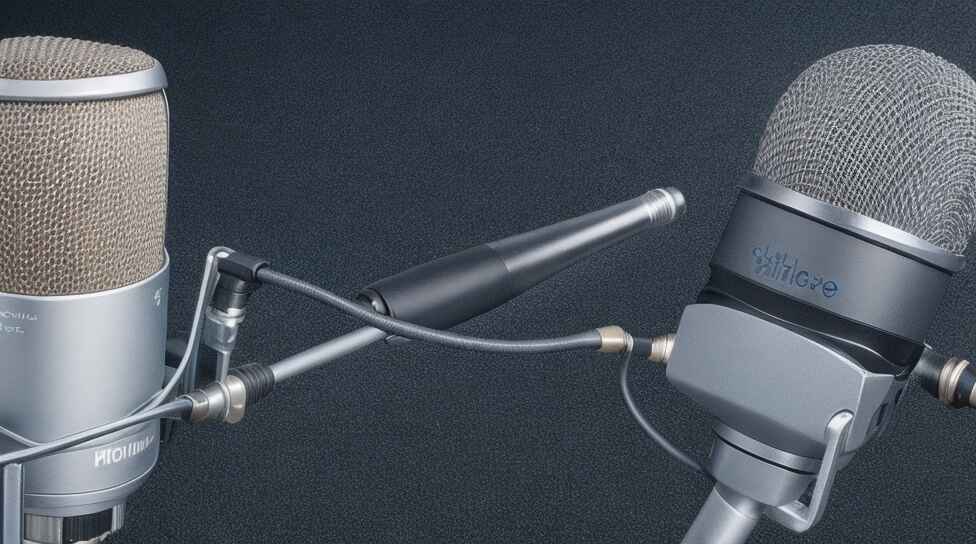Why is My Condenser Mic Not Working? Well, imagine this: you’re about to drop some lyrical genius, but your mic decides to go on a coffee break!
Don’t fret, we’ve got the troubleshooting tips to turn that silent mic into a vocal superstar. Let’s dive in!
Why is My Condenser Mic Not Working?

Before we delve into the nitty-gritty of troubleshooting, let’s address the central question: Why is my condenser mic not working?
This query can lead to a myriad of issues, and the answer isn’t always straightforward.
To demystify this enigma, we’ll explore various aspects that can impact your microphone’s performance.
Electrical Interference and Buzzing
One of the most frustrating issues you may encounter with your condenser microphone is the dreaded electrical interference, often manifesting as an annoying buzzing sound.
This problem can arise from several sources, but fear not—we’re here to help you identify and eliminate it.
Electrical Interference May Cause Buzzing In Your Condenser Microphone
Electrical interference can be a major culprit behind your condenser mic troubles.
When your microphone picks up stray electromagnetic signals from nearby electronic devices, it can result in a constant buzzing or humming sound in your recordings.
This interference can come from computers, fluorescent lights, or even poorly shielded cables.
How To Isolate and Eliminate Electrical Interference
Now that you know the potential source of your mic’s buzzing dilemma, let’s explore some practical solutions:
- Separation: Ensure that your microphone is placed away from electronic devices, power cables, and other potential sources of interference. Creating physical distance can make a significant difference.
- Shielded Cables: Invest in high-quality shielded cables for your microphone setup. These cables are designed to minimize interference and provide a cleaner audio signal.
- Grounding: Properly ground your audio equipment and electrical outlets. Ground loops can contribute to buzzing issues, and grounding can help alleviate them.
- Ferrite Beads: Consider using ferrite beads on your microphone cables. These small, magnetic devices can help suppress interference and improve audio quality.
- Noise Filters: If you’re still experiencing interference, consider using noise filters or suppressors to clean up your audio signal.
Good Tips
- Regularly inspect and maintain your cables and connectors to ensure they’re in good working condition.
- Experiment with microphone placement to find the optimal position that minimizes interference.
- Consult with a professional audio technician if you’re unable to resolve the issue on your own.
Background Noise and Mic Sensitivity
Condenser microphones are renowned for their sensitivity, which is a double-edged sword.
While they excel at capturing subtle nuances in sound, they are equally adept at picking up background noise.
This sensitivity can be a blessing or a curse, depending on your recording environment.
Your Condenser Mic Will Pick Up Background Noise In Your Room
If your condenser mic is capturing more ambient noise than your intended audio source, it can lead to poor recording quality.
Background noise can include air conditioning hums, street sounds, or even the soft rustling of papers in the background.
Faulty Cables And Connectors
In addition to interference, faulty cables and connectors can also plague your condenser microphone setup.
Even a minor issue with your XLR connectors or cables can result in signal loss or distorted audio.
XLR Connectors Reduce Buzz And Hum
To mitigate potential problems caused by cables and connectors, consider the following steps:
- Inspect Cables: Regularly examine your microphone cables for any signs of wear, kinks, or damage. Replace any compromised cables immediately.
- Quality XLR Connectors: Invest in high-quality XLR connectors, as they are less prone to signal degradation and interference.
- Secure Connections: Ensure that all connections, including XLR connectors, are securely fastened. Loose connections can result in erratic microphone behavior.
- Test with Another Mic: If possible, test your microphone setup with another microphone to determine if the issue lies with the mic itself or the cables/connectors.
Damaged Microphone
While it’s not pleasant to contemplate, sometimes the issue may be with the condenser microphone itself.
Microphones are delicate instruments, and physical damage or wear and tear over time can lead to performance issues.
Discover Best Quick Review’s recommended microphones for Studio-Quality Sound in the following articles: Best Condenser Mic Under $200 for Studio-Quality Sound
Technical Issues: Unraveling the Buzzing Mysteries

Now that we’ve explored some common problems related to condenser microphones, let’s dive deeper into the technical issues that might be behind the buzzing in your recordings.
Check Your Gain Settings
Your microphone’s gain settings can significantly impact the quality of your audio. If your gain is set too high, it can lead to distorted and noisy recordings.
Conversely, setting it too low can result in barely audible sound. Finding the right balance is crucial for optimal performance.
Are You Using A USB Condenser Microphone?
USB condenser microphones have become increasingly popular due to their ease of use and plug-and-play functionality.
However, they can be more susceptible to certain technical issues, including buzzing.
If you’re using a USB mic, it’s essential to consider its unique characteristics when troubleshooting.
A Loose Connection Can Cause Mic Buzzing
Loose connections are a common culprit behind buzzing sounds in your microphone.
This issue can occur at various points in your setup, including the microphone cable, XLR connectors, or audio interfaces.
Inspecting and securing these connections is a fundamental step in resolving buzzing problems.
A Ground Loop Will Create A Buzzing Sound
Ground loops can plague audio setups and are notorious for causing unwanted buzzing and humming sounds.
These loops occur when there are multiple paths for electrical current to ground, leading to interference in your audio signal. Identifying and eliminating ground loops is essential for pristine audio quality.
Studio Monitors Or Headphones May Be The Source Of The Buzzing
Sometimes, the buzzing might not originate from your microphone at all.
Studio monitors or headphones can introduce unwanted noise into your recordings if they are malfunctioning or have poor shielding.
Investigating your playback equipment is a crucial step in diagnosing and resolving buzzing issues.
Wireless Microphones Are More Susceptible To Interference And Buzzing
While wireless microphones offer unparalleled mobility, they can be more susceptible to interference and buzzing than their wired counterparts.
Radio frequency interference (RFI) and other wireless-specific issues can disrupt your microphone’s performance.
Understanding and mitigating these challenges is essential for wireless microphone users.
Dirty Power Coming Into Your Home Recording Studio
The quality of the power supply in your home recording studio can affect the performance of your condenser microphone.
Dirty power, characterized by voltage fluctuations and electrical noise, can introduce buzzing and other unwanted artifacts into your recordings.
Investing in power conditioning equipment may be necessary to ensure clean and stable power for your setup.
Discover essential information about Condenser Mic Make You Sound Better in my article: Does a Condenser Mic Make You Sound Better? Elevate Sound
Insights and Solutions: Unveiling the Secrets to Optimal Microphone Performance

Now that we’ve explored various technical issues that can affect your condenser microphone’s performance, let’s delve into some valuable insights and solutions to help you navigate the world of audio recording with confidence.
What Others Are Saying
Before we dive into specific solutions, it’s worth considering what experiences others have had with their condenser microphones.
Online forums, user reviews, and community discussions can offer valuable insights into common problems and potential fixes. Learning from the experiences of fellow enthusiasts and professionals can save you time and frustration.
Top Reasons Why Your Condenser Microphone is Too Quiet
A common complaint among condenser microphone users is that their recordings are too quiet.
Understanding the root causes of this issue is essential for achieving the desired audio levels in your recordings.
Low Input Gain is the Main Reason Why Your Condenser Mic is Too Quiet
Input gain refers to the amplification of the audio signal as it enters your recording equipment.
If your input gain is set too low, your microphone’s output will be insufficiently boosted, resulting in recordings that are too quiet. Adjusting the input gain to an appropriate level can make a substantial difference.
No Phantom Power Supply
Many condenser microphones require phantom power to operate. If you neglect to supply phantom power when needed, your microphone may not function correctly, resulting in low output levels.
Ensure that your audio interface or mixer is providing the necessary phantom power to your microphone.
Get detailed insights into Condenser Mic Without Phantom Power from my article: Can You Use a Condenser Mic Without Phantom Power?
Not Connected to Mic Input
It may sound simple, but overlooking the basics can lead to quiet recordings.
Ensure that your microphone is correctly connected to the designated mic input on your audio interface or mixer. Plugging it into a line input can result in low signal levels.
Using the Wrong Audio Cable
The type of audio cable you use matters. Using the wrong cable, such as an instrument cable instead of a proper microphone cable, can lead to signal loss and reduced audio levels. Make sure you’re using the appropriate cable for your microphone.
Using a Defective Audio Cable
Even if you have the right cable, it’s essential to inspect it for any defects or damage.
A damaged cable can introduce unwanted noise and attenuate your microphone’s signal. Regularly check and replace cables to maintain optimal performance.
Attenuation Pad is Switched On
Some microphones feature an attenuation pad that reduces the input signal’s level.
Accidentally activating this pad can result in lower microphone output. Verify that the attenuation pad is set to its default position or as needed for your recording scenario.
Mic Position Can Make Your Condenser Microphone Too Quiet
Microphone placement is a critical factor in capturing the desired sound.
If your microphone is too far from the sound source or pointed in the wrong direction, it may pick up less audio, leading to quiet recordings.
Experiment with mic placement to find the sweet spot for your particular recording.
Your Mic Isn’t Too Quiet, You Are Just Monitoring It Incorrectly
Sometimes, the perception of a “too quiet” microphone may stem from monitoring issues.
Ensure that you’re using quality headphones or studio monitors and that your monitoring volume is set appropriately.
Additionally, consider using audio meters and headphones with proper impedance to accurately gauge audio levels.
FAQs About Why is My Condenser Mic Not Working
Why the condenser mic is not working?
If your condenser microphone is not working, first check the connections. Ensure it’s properly plugged into the correct input on your audio interface or mixer.
Also, confirm that phantom power (if required) is turned on, and the mic isn’t muted in your recording software.
How do I get my condenser mic to work?
To get your condenser mic to work, make sure it’s connected correctly, and if it needs phantom power, activate it.
Adjust the input gain on your audio interface, and check your recording software settings to ensure it’s selected as the input source.
How do I know if my condenser mic is damaged?
Signs of a damaged condenser mic include distorted or no audio output, unusual noise, or physical damage like dents or loose parts.
Testing it with another device or cable can help confirm if it’s the mic or another component causing the issue.
What can damage a condenser microphone?
Condenser mics are sensitive and can be damaged by excessive humidity, physical shocks, and voltage surges.
Mishandling, dropping, or exposing the mic to extreme conditions can also lead to damage.
Do condenser mics have batteries?
Most condenser microphones do not have built-in batteries. Instead, they often rely on phantom power supplied by an audio interface or mixer.
However, some USB condenser mics have internal batteries for power.
Do condenser mics need batteries?
Typically, condenser mics do not require batteries, as they use phantom power or plug directly into a power source through an audio interface.
Check your microphone’s specifications to confirm its power requirements.
Do condenser mics break easily?
Condenser mics are delicate and more sensitive than dynamic mics.
While they are not extremely fragile, they can be damaged if mishandled or exposed to harsh conditions. Proper care and storage are essential to prevent damage.
Do condenser mics wear out?
Condenser microphones can have a long lifespan if well-maintained.
However, like all electronic devices, they may eventually wear out due to repeated use or component degradation. Regular cleaning and careful handling can extend their life.
How do you test a condenser mic?
To test a condenser microphone, plug it into a compatible audio interface or recording device.
Record a sound or your voice and monitor the audio output. Ensure that the recorded sound is clear, free of distortion, and at an appropriate volume level.
Final Thoughts About Why is My Condenser Mic Not Working
In the intricate world of audio recording, encountering issues with your condenser microphone is not uncommon.
From electrical interference to technical glitches, a range of factors can contribute to these problems.
However, with patience, troubleshooting skills, and the insights shared in this comprehensive guide, you can overcome these challenges.
Remember that a methodical approach is key, whether you’re dealing with buzzing, low volume, or other issues.
By understanding the intricacies of your condenser microphone and the recording environment, you can restore pristine audio quality and continue creating captivating content with confidence.
So, fear not the question, “Why is my condenser mic not working?”—embrace it as an opportunity to enhance your audio recording journey.
